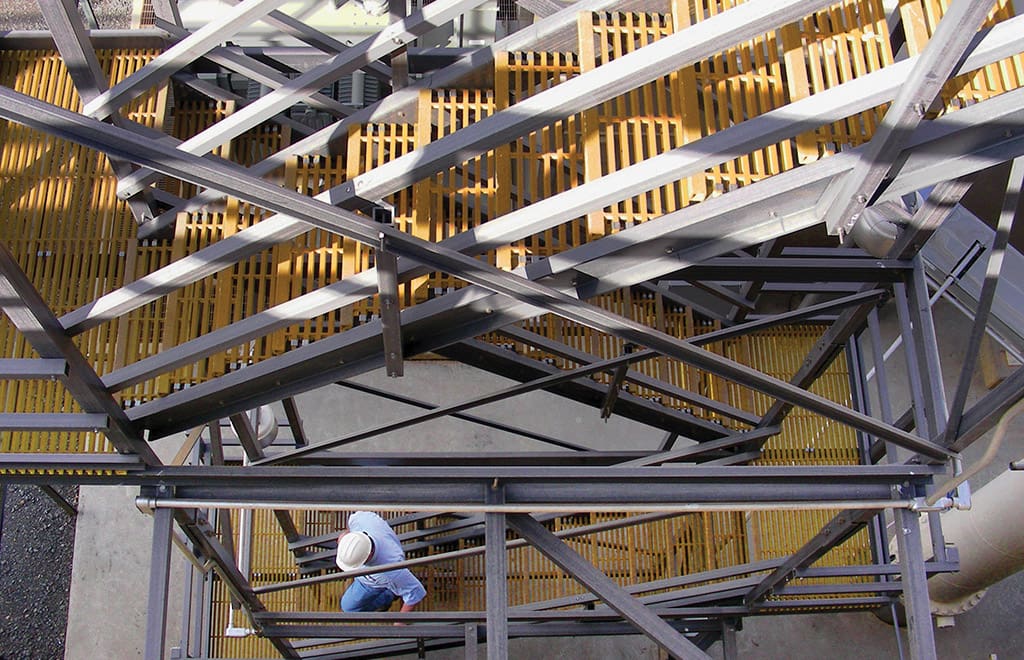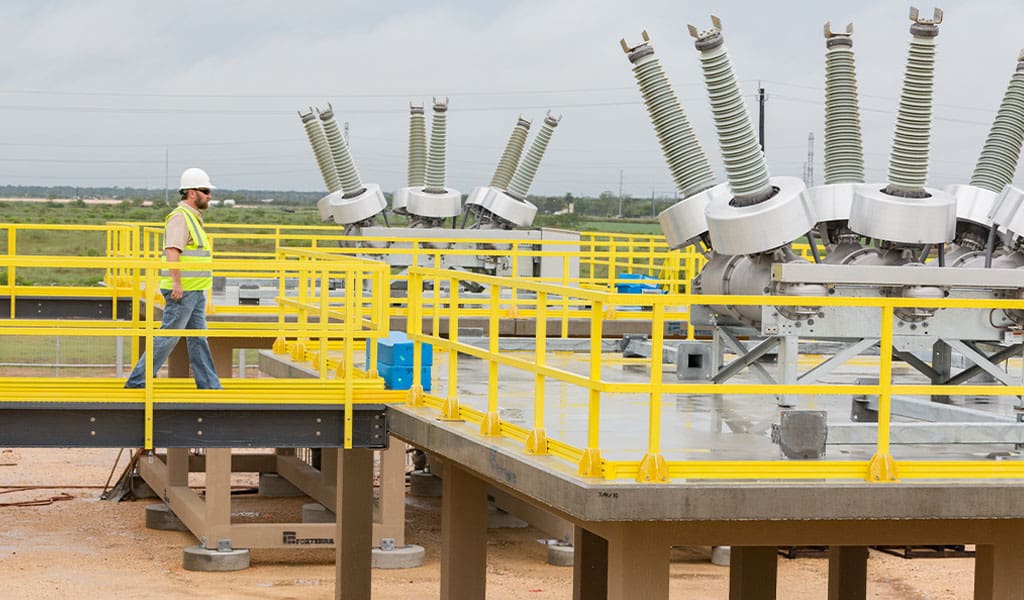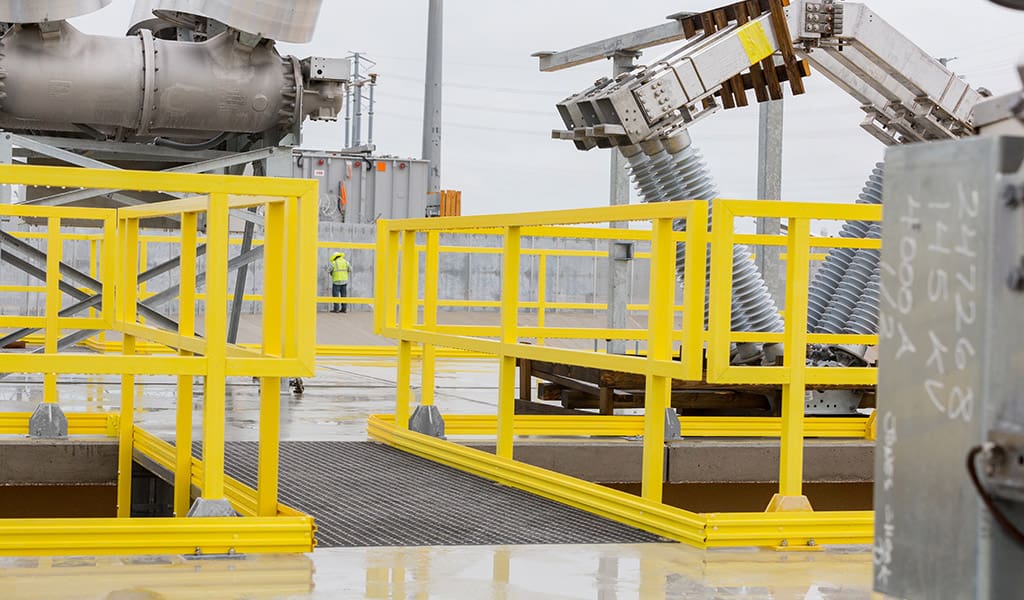In the dynamic landscape of power plant operations, ensuring workplace safety is a paramount concern for employers and employees. The need for robust safety measures cannot be overstated. It is essential for the well-being of workers, the economic health of businesses, and the uninterrupted flow of power generation. As we take a close look at plant safety, it becomes evident that proactive planning and the adoption of cutting-edge solutions are pivotal in safeguarding against potential hazards in power plant environments.
According to the National Safety Council, workplace injuries cost over $167 billion in 2022 alone. This underscores the urgent need for comprehensive safety protocols and structural solutions that mitigate risks effectively. Among the array of materials available for constructing safety infrastructure, fiberglass-reinforced polymer (FRP) emerges as a standout choice, offering numerous advantages in terms of durability, resilience and safety.

Constructing for Safety
FRP structures offer unparalleled durability and adaptability, standing as a testament to evolving safety practices. Investing in FRP solutions is a smart choice for businesses navigating modern power plant operations. By prioritizing safety and embracing innovative materials, employers can foster a culture of security, safeguarding both their workforce and their bottom line.
FRP is a versatile and robust material, offering advantages that make it ideal for ensuring workplace safety, particularly in environments where traditional materials may corrode, rust, warp, or pose additional safety concerns.
- Exceptional Durability: FRP exhibits remarkable resilience in extreme environmental conditions, resisting cracking or splitting in high heat or extreme cold. FRP does not buckle under heavy weight, ensuring structural integrity even in demanding applications. This durability makes FRP an ideal solution for a wide range of workplace safety applications, from industrial platforms to access ladders.
- Corrosion Resistance: One of the primary advantages of FRP is its inherent resistance to rust and corrosion. Structures made with FRP remain unaffected by exposure to humidity, liquids or corrosive substances, ensuring longevity and reliability. Unlike metal structures that may weaken and fail over time due to corrosion, FRP maintains its integrity, offering long-term protection against workplace hazards.
- Ingrained Safety Features: The safety yellow coloring of FRP is integrated into the material itself, eliminating the need for painting. This not only reduces maintenance efforts but also minimizes the risk of scrapes, tripping hazards and aesthetic degradation caused by peeling or cracking coatings.
- Chemical Resistance: FRP’s resistance to chemicals further enhances its suitability for a wide range of industrial environments, eliminating concerns about structural weakening or the formation of tripping hazards. This resistance ensures consistent performance and reliability, even in the most challenging settings.
- Non-Conductivity: Unlike metals, which can conduct electricity and pose a risk of electric shock, FRP provides insulation against electrical currents, ensuring the safety of workers and equipment. This makes FRP an ideal choice for applications where exposure to electrical systems is prevalent, such as power plants and industrial facilities.
- Dimensional Stability: FRP exhibits minimal expansion and contraction in response to temperature fluctuations. This reduces the risk of structural weaknesses or failures that could compromise workplace safety. Additionally, FRP does not attract insects that can weaken structures, making it suitable for long-term use in industrial environments.

Incorporating Safety Principles into Workplace Design
Aldred D’Souza, P.E., M.ASCE, Engineering Director at Bedford Reinforced Plastics, brings invaluable expertise to the discourse on industrial plant safety. With nearly 25 years of experience in the FRP industry, D’Souza emphasizes the critical role of proper design and material selection in ensuring workplace safety.
“Danger lurks in seemingly mundane elements such as staircases and handrails if not designed and installed to proper standards,” D’Souza remarks. “The heart of effective safety lies in mitigating slips, trips and falls, which can have catastrophic consequences if overlooked.”
He underscores the importance of incorporating materials that are anti-skid, corrosion-resistant and non-conductive to minimize safety risks effectively. The choice of building materials and the design of safety structures play a pivotal role in mitigating risks and promoting a secure working environment.
“When it comes to constructing safety infrastructure, the primary objective is to route people away from danger zones while ensuring that safety structures themselves are engineered to minimize the risk of accidents. Slips, trips, falls and electrical shocks are among the most common workplace hazards that can have severe consequences if not adequately addressed,” continues D’Souza. “This is why companies like Bedford Reinforced Plastics prioritize the incorporation of safety features such as anti-skid surfaces, dent resistance, corrosion resistance and non-conductivity into their materials. By utilizing these materials, plant safety managers can avoid the headaches associated with safety lapses and maintain productivity levels.”
Moreover, designing or repairing workplace environments with safety in mind requires careful consideration of various factors. Facility and plant maintenance professionals must start by assessing the specific application and identifying potential risks. For instance, when designing a platform, it is essential to determine the load requirements, anticipate elevation changes and assess exposure to chemicals or heavy machinery movement.
By understanding the unique challenges posed by the work environment, professionals can make informed decisions regarding platform strength, guardrail selection, stair or ladder length and other critical aspects of safety infrastructure. This proactive approach not only enhances workplace safety but also contributes to the overall efficiency and productivity of operations. By prioritizing safety in every aspect of workplace design and maintenance, businesses can create a secure and conducive environment for their employees, fostering a culture of well-being and productivity.
Real-World Applications
One example highlighting the efficacy of FRP structures in enhancing workplace safety is a power station in Pennsylvania. This nuclear power plant faced stringent safety regulations due to the nature of its operations. By leveraging FRP solutions from Bedford Reinforced Plastics, the power station has bolstered its safety infrastructure, mitigating potential hazards and ensuring a secure working environment for its personnel.
In another example, a Bedford distributor based in Houston, Texas, highlights the transformative impact of Bedford’s FRP materials in a project at a Texas Gulf Coast electrical substation.

Humid Gulf Coast areas like Houston call for building materials that stand up to the elements. Bedford’s FRP was the ideal solution for this electrical substation.
The distributor explains the challenges faced by power structures like electrical substations, particularly grounding issues with traditional metal components. “In place of metal handrails, we used structural fiberglass that doesn’t have to be grounded, eliminating groundwork,” he notes.
The jobsite’s proximity to waterways introduced additional complications, including corrosive saltwater spray and flood risks. “We needed products that withstand flooding waters and are UV-resistant so the sun rays don’t deteriorate the product,” says the distributor. Comparing FRP to traditional materials like steel or aluminum, he emphasizes its durability and low maintenance. “We don’t have problems with warping or corrosion. We also don’t have to worry about maintenance, such as painting or special installation,” he concludes.
Prioritizing Workplace Safety
The pursuit of workplace safety demands meticulous planning and innovative solutions. FRP structures offer unparalleled durability and adaptability, standing as a testament to evolving safety practices. Investing in FRP solutions is a smart choice for businesses navigating modern power plant operations. By prioritizing safety and embracing innovative materials, employers can foster a culture of security, safeguarding both their workforce and their bottom line.
To learn more about how FRP products can enhance safety in your workplace, reach out to our team for more information, request a quote or call 814-623-8125 to discuss the details of your project.
This article was originally published in POWER Magazine.